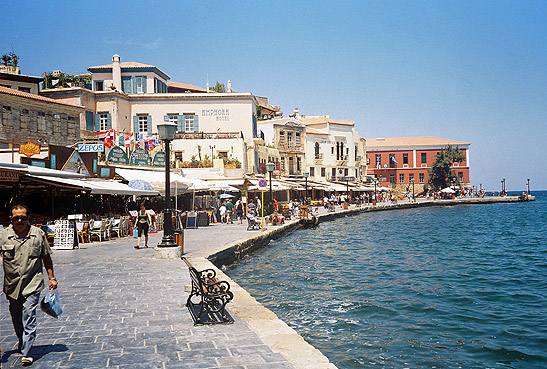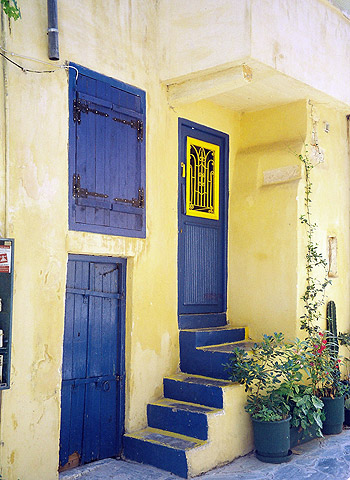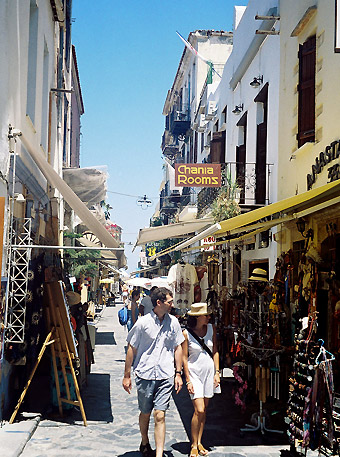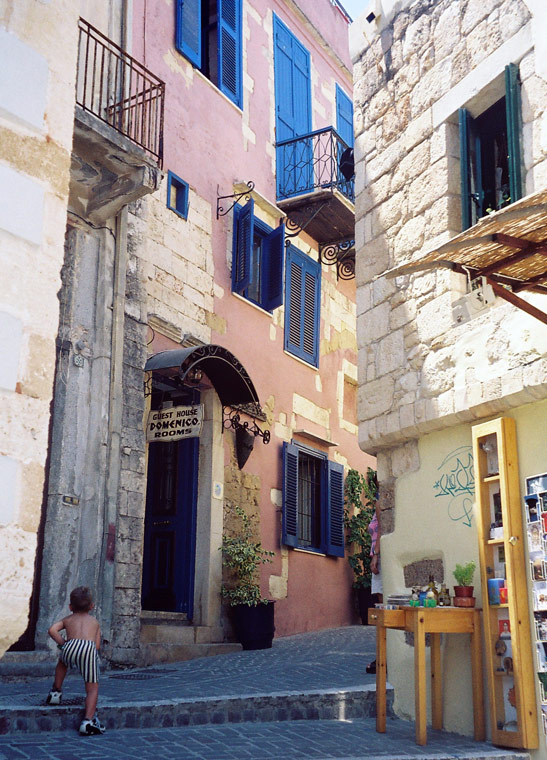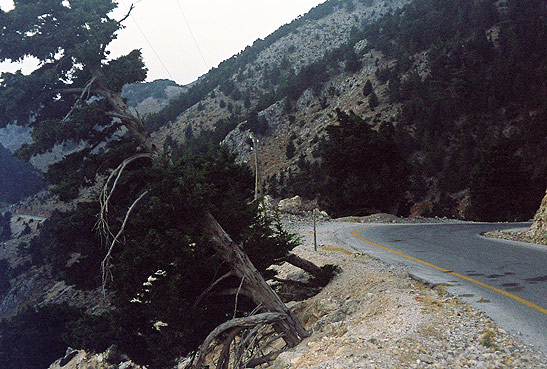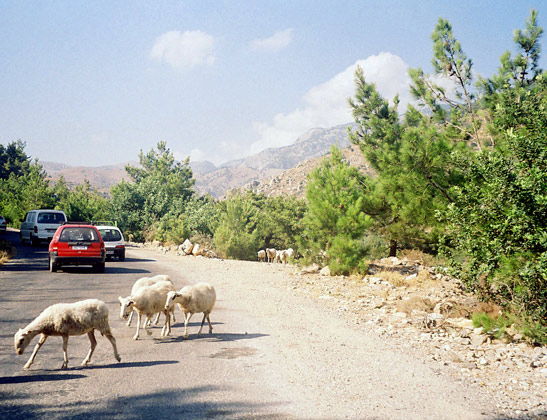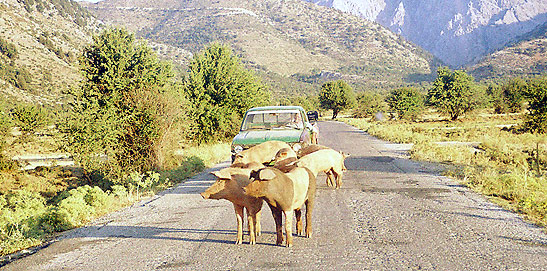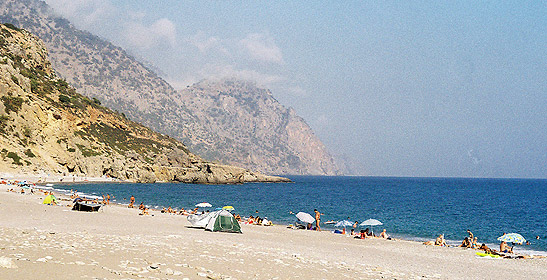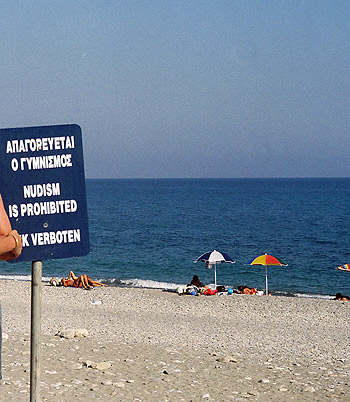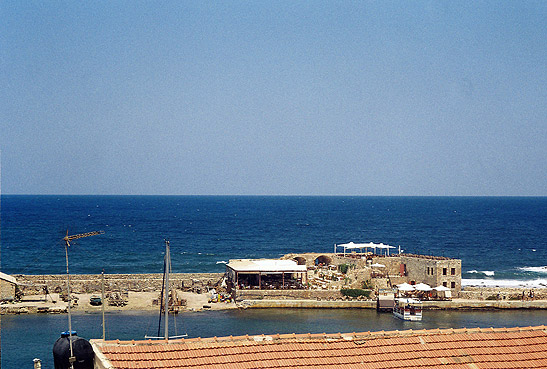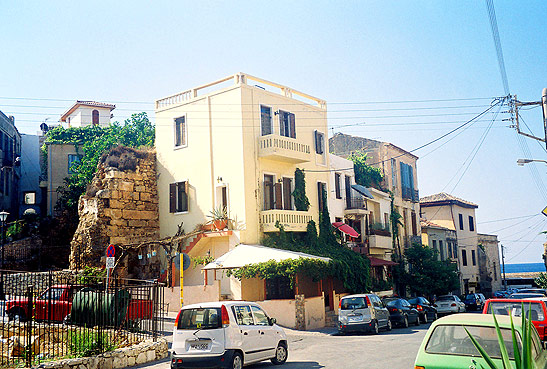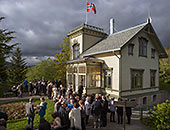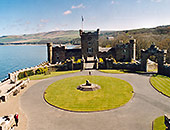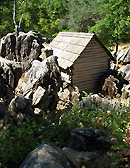 |
 |
|
 |

|
Crete:
When an old friend from Greece invited the author to
spend a week on the Isle of Crete during July, his eyes opened wide.
He envisioned white sandy shores, clear aquamarine water, blistering
sunrays and hordes of American tourists, all with farmer’s tans.
He would not be alone.
The author acquired a slight tan that day, but nowhere near enough, so a trip to the beach became a necessity. Crete’s beaches need no introduction, but those near Chania usually fill up with tourists, so he opted to explore a much more remote location: the southern coast of the island. Which required a drive through the Lefka Ori (White Mountains), a trip along a road that seemed to change, in every respect, with the moods of the day. Sometimes paved and sometimes not, the mountain road snaked its way through uncompromising peaks and tranquil valleys, always distracting the driver with views of harrowing switchback paths that were yet to come.
The drive provided a multitude of shifting scenarios. One minute, overwhelming stenches of billy-goats dominated the scene, while the next, aromas of thyme, sage and wildflowers took over. Talk about local flavor. For a few miles the road bisected a plateau spotted with dark green shrubs and then suddenly it moved along a steep precipice of nothing but silvery gray rock, falling off the edge at a 100-metre drop. For one mile, the driver scooted along a flank of mahogany brick and within a second he suddenly reverberated from a colorful symphony of flora—cherry, bright yellow and lavender. The smattering of scenery robbed his attention and he almost drove over the cliff a couple of times. The temperature fluctuated without any prior anticipation, often dropping five degrees as the road merely turned a corner.
An obstinate herd of nomadic pigs even blocked the road at one point, forcing the driver to stop until a man in a jeep approached from the opposite direction. The man lowered his arm out the window and banged his hand on the side of his vehicle a few times, urging the pigs to meander away. And they did.
After going over the top of the White Mountains, the narrow road eventually descended through more of the same and collapsed at Sougia, an isolated beach town on the southern coast of Crete. Sougia was the target destination: no tourists, no big hotels, no prearranged rows of sun beds.
Sougia temporarily satisfied the author’s longing: crystal-clear aquamarine water, half-pebbly white sand and tree-flanked leisure paths beckoning one for a few beers at the beachfront taverns. A few scattered umbrellas and dome tents dotted the sand where campers had set up shop. An occasional mountain goat emerged from the nearby hills and wandered down to the rocks. Since the beach was nearly empty, he chose a roomy spot to work off his farmer’s tan. A glaring sign cautioned that nudism wasn’t allowed, but once he reached the far end of the beach, he noticed almost everyone was indeed in the buff.
Regardless of what dreck the dermatologists might spew, there are only two ways to go about this tanning thing: (1) Spend many days at the beach, about two hours a day, with adequate amounts of lotion, and even out your farmer’s tan safely and gradually. This option is suitable for sedentary types who go through life thriving on security and predictability, and whose character traits include self-discipline and rational consideration of the results of their actions ahead of time. (2) Sit out in the blazing sun all day with no lotion and roast yourself like a pig. You acquire your major tan in just one day, but then you have to wait two weeks for the burns to go away and the dead skin to fall off. This plan works for impulsive, spontaneous individuals with restless brain chemistry, those who go high hog and take their punishment later.
Naturally, the author chose the second option and wound up with sunburns almost everywhere. His torso and legs were beet-red by the time he left. The next morning, he could barely roll over in bed because it hurt so much. About a week later, after he had returned home, he shed flakes of dead skin all over his apartment for two weeks.
Despite the extreme masochistic nature of this endeavor, it did not ruin the rest of his trip in the slightest bit. He immersed himself in the quality of Cretan life. That same night, he drank an ocean of Tsikoudia and danced to Greek music on a rooftop amidst crumbling ruins overlooking the harbor. And he gorged on enough lamb chops and souvlaki to feed three people. His faith was back. He knew he could return home and eventually parade around Northern California with his shirt off. No one would laugh at his farmer’s tan anymore.
|
|
Your tea adventures are especially interesting because I've always associated tea with British etiquette or a bevy of women wearing dainty victorian costumes and sipping tea with their little pinky sticking out. To see Tea from a man's perspective brings new light in a man's psyche. I've been among the many silent admirers of your writings for a long time here at Traveling Boy. Thanks for your very interesting perspectives about your travels. Keep it up! --- Rodger, B. of Whittier, CA, USA
|
|
| ||||
|
| ||||
This site is designed and maintained by WYNK Marketing. Send all technical issues to: support@wynkmarketing.com

|






